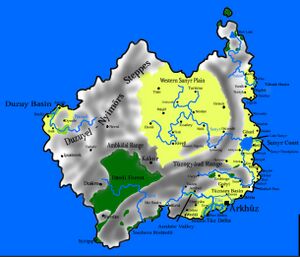Etzeá: Difference between revisions
Jukethatbox (talk | contribs) No edit summary |
Jukethatbox (talk | contribs) No edit summary |
||
| Line 2: | Line 2: | ||
{{Infobox language | {{Infobox language | ||
| name = Etzeá | | name = Etzeá | ||
| nativename = | | nativename = etzeá | ||
| pronunciation = | | pronunciation =eˈd͡zea̯ | ||
| creator = User:Jukethatbox | | creator = User:Jukethatbox | ||
| created = 2023 | | created = 2023 | ||
| Line 11: | Line 11: | ||
| state = Etzeán Island | | state = Etzeán Island | ||
| stand1 = Etzeá Standard | | stand1 = Etzeá Standard | ||
| dia1 = Duzuyel-Nyimörs dialects | | dia1 = Duzuyel-Nyimörs dialects | ||
| dia2 = Southern Sunyr dialects<br> | | dia2 = Southern Sunyr dialects<br> | ||
| Line 20: | Line 19: | ||
| mapcaption = Etzeán Island. Most Etzeá speakers live on the western side of the island, past the Tûzogyâud Range. | | mapcaption = Etzeán Island. Most Etzeá speakers live on the western side of the island, past the Tûzogyâud Range. | ||
}} | }} | ||
'''Etzeá'''('' | '''Etzeá'''(''etzeá''; [[Help:IPA|[eˈd͡zea̯]]]) is the secondary language spoken on the island of Etzeán within the Moshurian Empire. | ||
It is linguistically interesting because, philologically speaking, it is the closest living relative to [[Proto-Yeldhic]] in the Yeldhic language family. | It is linguistically interesting because, philologically speaking, it is the closest living relative to [[Proto-Yeldhic]] in the Yeldhic language family. | ||
==History== | ==History== | ||
===Etymology=== | ===Etymology=== | ||
The name ''etzeá'''s etymology is heavily debated, though one theory is that it developed agglutinatively by the combination of one word and a case marker: Proto-Yeldhic ''* | The name ''etzeá'''s etymology is heavily debated, though one theory is that it developed agglutinatively by the combination of one word and a case marker: Proto-Yeldhic ''*etsu'', "land" and ablative case marker ''*-ē'', or in other words, ''*etsʷē'', "away from the mainland". | ||
===Formation=== | ===Formation=== | ||
The first Etzeic peoples were a Proto-Yeldhic people who probably inhabited Kokiso Point, the closest coastal landmark on Talkoch to Etzeán Island. They probably arrived on Etzeán Island around 2400 UH, just in time before the development of the Paleoyeldhic languages on the mainland in 2370 UH. On Etzeán Island, the Etzeic peoples spread all the way to the Tûzogyâud Range by 1750 UH. The areas around Mount Ogoñi was settled later, around 1600 UH. | The first Etzeic peoples were a Proto-Yeldhic people who probably inhabited Kokiso Point, the closest coastal landmark on Talkoch to Etzeán Island. They probably arrived on Etzeán Island around 2400 UH, just in time before the development of the Paleoyeldhic languages on the mainland in 2370 UH. On Etzeán Island, the Etzeic peoples spread all the way to the Tûzogyâud Range by 1750 UH. The areas around Mount Ogoñi was settled later, around 1600 UH. | ||
| Line 31: | Line 30: | ||
===Orthography=== | ===Orthography=== | ||
===Consonants=== | ===Consonants=== | ||
{| class=wikitable style="text-align: center;" | |||
! !! Labial !! | |||
|} | |||
===Vowels=== | ===Vowels=== | ||
===Prosody=== | ===Prosody=== | ||
| Line 40: | Line 42: | ||
===Morphophonology=== | ===Morphophonology=== | ||
==Morphology== | ==Morphology== | ||
==Syntax== | ==Syntax== | ||
===Constituent order=== | ===Constituent order=== | ||
| Line 59: | Line 48: | ||
===Sentence phrase=== | ===Sentence phrase=== | ||
===Dependent clauses=== | ===Dependent clauses=== | ||
==Example texts== | ==Example texts== | ||
==Other resources== | ==Other resources== | ||
<!-- Example: Word order, qualifiers, determinatives, branching, etc. --> | <!-- Example: Word order, qualifiers, determinatives, branching, etc. --> | ||
Revision as of 22:30, 5 October 2024
This article is a construction site. This project is currently undergoing significant construction and/or revamp. By all means, take a look around, thank you. |
| Etzeá | |
|---|---|
| etzeá | |
| Pronunciation | [eˈd͡zea̯] |
| Created by | Jukethatbox |
| Date | 2023 |
| Native to | Etzeán Island |
Yeldhic
| |
Standard form | Etzeá Standard
|
Dialects |
|
| Official status | |
Recognised minority language in | Moshurian Empire |
 Etzeán Island. Most Etzeá speakers live on the western side of the island, past the Tûzogyâud Range. | |
Etzeá(etzeá; [eˈd͡zea̯]) is the secondary language spoken on the island of Etzeán within the Moshurian Empire.
It is linguistically interesting because, philologically speaking, it is the closest living relative to Proto-Yeldhic in the Yeldhic language family.
History
Etymology
The name etzeá's etymology is heavily debated, though one theory is that it developed agglutinatively by the combination of one word and a case marker: Proto-Yeldhic *etsu, "land" and ablative case marker *-ē, or in other words, *etsʷē, "away from the mainland".
Formation
The first Etzeic peoples were a Proto-Yeldhic people who probably inhabited Kokiso Point, the closest coastal landmark on Talkoch to Etzeán Island. They probably arrived on Etzeán Island around 2400 UH, just in time before the development of the Paleoyeldhic languages on the mainland in 2370 UH. On Etzeán Island, the Etzeic peoples spread all the way to the Tûzogyâud Range by 1750 UH. The areas around Mount Ogoñi was settled later, around 1600 UH.
Phonology
Orthography
Consonants
| Labial |
|---|
